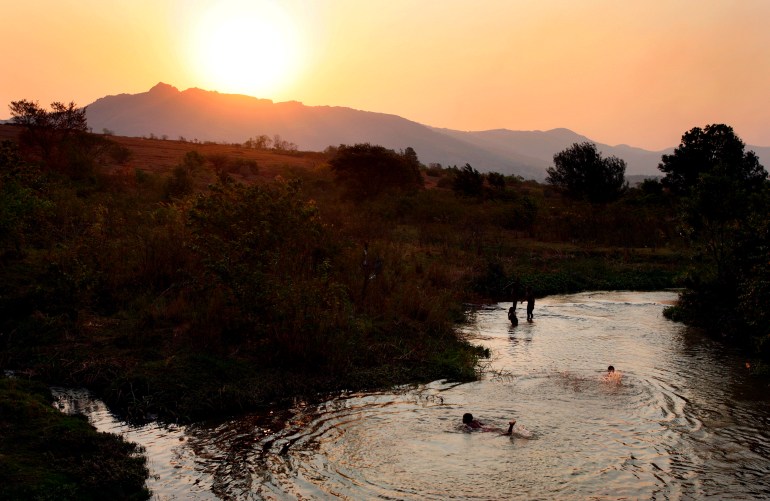
Lubombo, Eswatini – In the heart of the Jilobi Forest, a biodiversity hotspot in Eswatini’s eastern region of Lubombo, the three chiefdoms inhabiting the territory had longstanding disputes, and tensions used to run high.
But recently, an urge to preserve their shared land has caused them to retire their rivalry.
“There were disputes over boundary lines and resources management that strained relations and hindered peaceful coexistence,” said Muzi Maziya, a 32-year-old from the Lukhetseni constituency, one of the chiefdoms in the remote area of the country formerly known as Swaziland.
“Most of the disputes resulted in illegal activities like wood-cutting and livestock theft by outsiders and people from the communities who took advantage of the polarisation.”
The rivalries, which date back to the 1980s among the chiefdoms of Maphungwane, Tikhuba and Lukhetseni, posed a grave threat to the diversity of the Jilobi Forest, according to environmentalists.
“Borders disputes have been a persistent challenge, leading to a tense relationship among the chiefdoms,” Chief Maliwa Maziya of Maphungwane, the largest chiefdom inhabiting the forest, told Al Jazeera.
“The rivalry often led to illegal activities such as livestock theft,” he said. Members of one community would steal cattle that belonged to a neighbouring chiefdom in a bid to discourage farmers from grazing on land under dispute.
Problems worsened when outsiders took advantage of the tensions and moved into the area, soon consuming much of the resources.
This resulted in the poaching of wild animals, such as warthogs and Samango monkeys, and illegal harvesting of plants for medicines and food.
Collective efforts
The forest holds cultural significance for the Maziya clan of Maphungwane and for the Dlaminis of Lukhetseni, said Nomsa Mabila, a project manager at the local environmental nonprofit Indalo Eswatini.
The forest is also where locals from the Maziya and Dlamini clans bury family members. It is a common belief among communities that the souls of their ancestors roam the forests, hence they believe the land should be preserved and never disturbed, Mabila told Al Jazeera.
But “unsustainable land practices, medicinal plant harvesting without consent and poaching have threatened this natural treasure,” she said.

Thembisile Myeni is a small-scale farmer in this region. She told Al Jazeera she believes locals know best when it comes to conservation.
For generations, the people of the Tikhuba, Maphungwane and Lukhetseni chiefdoms have depended on their intertwined relationship with the Jilobi Forest for survival and consider themselves to be the custodians of this invaluable natural resource, Myeni explained.
People regularly employ sustainable farming practices that include protecting the area from pests and diseases and avoiding protected areas, she said.
“In our communities, there are collective efforts in preserving the forest against threats,” she told Al Jazeera.
Bhekithemba Matsenjwa, a Maphungwane community member, also emphasised the pivotal role the forest plays in people’s lives.
“It has a rich ecosystem and is home to endangered species like the endemic cycad and Samango monkey.”
The ironwood tree, locally known as Bukhunkhu in SiSwati, also grows abundantly in the forest. Matsenjwa shed light on its significance for the Maphungwane.
“It has versatile uses, from house construction to furniture making, and is an all-around important resource for the community,” he said, emphasising that the communities living around the forest use responsible and sustainable harvesting practices and know not to damage the forest but to replenish its resources.
Biodiversity hotspot threatened
However, when the chiefdoms were at loggerheads and disputes arose between them over borders and whose livestock should be allowed to graze where, conservation was not always a priority.
Mabila from Indalo Eswatini, which advocates the management of natural resources in high biodiverse landscapes, noted that while the rivalries persisted, animals living in the forest were quickly being wiped out by poachers.

“Recent surveys have shown the rich biodiversity and unique butterflies found in the Jilobi Forest. All these were at stake from the rapid harvesting of the forest that was taking place,” she said.
Over the past 20 years, a significant problem affecting Jilobi has been deforestation, Seth Maphalala, a biodiversity consultant and ecology expert, told Al Jazeera.
“The rural communities around this forest used the resources in the forest, including chopping down trees and never replacing them,” he said.
As the population surged, people from outside the three communities using the forest’s natural resources, particularly for traditional medicine, went unchecked, and the problem was exacerbated, Maphalala said.
“There were instances where people would debark a whole tree in an attempt to get enough resources for medicinal purposes.”
The forest’s cycads, plants that are endangered worldwide, and other flora in the forest are highly prone to poaching for their medicinal purposes.
In a bid to conserve the Jilobi Forest from repeated encroachment, it became essential for the chiefdoms to reconcile to jointly manage and protect the space.
So a group of local and international organisations intervened.
‘Collective heritage’
One of these interventions was an ecotourism development project that started in 2021, a collaborative effort between the Jilobi Joint Trust committee and Indalo Eswatini, Mabila said.
The project is helping locals to manage the forest sustainability while also paving the way for reconciliation between the chiefdoms – a step seen as necessary to scale back activities such as illegal logging and deforestation.
“Ultimately, talks were facilitated to help chiefs and communities recognise that the ongoing rivalry was detrimental not only to their collective heritage but also to the precious Jilobi Forest,” Mabila said.
Chiefdoms were receptive to altering course when they knew that the conservation of the forest would be particularly beneficial to their communities.
The Joint Management Committee was established in 2021 to help the three chiefdoms jointly manage the resources of Jilobi by coming together to devise a reforestation plan that involves responsible forestry practices such as responsible grazing and avoiding protected areas.
“We were able to sort out our differences,” Chief Maliwa said.
Because chiefs are a moral compass for their communities, it was essential to persuade them of the importance of conservation projects.
“[I] always encourage the community to invest in Jilobi by setting up businesses such as lodges,” the chief said.
“People were worried about where they were going to take their cattle for grazing if some parts of [Jilobi] were off limits. I told them that we have plenty of land in the area. They listened,” he said about having barred his people from using the forest as grazing land.
Despite conflicting opinions among the chiefdoms about whether tourists might have a negative impact on the forest, Maliwa said that will not necessarily be the case.
“The trails which will be used by tourists are already set up to get the best views of the forest without having to cut down any trees,” he said.

Meanwhile, workshops were added as another pillar of the programme, Mabila said, to “make the larger community aware of the value of biodiversity and the role of Jilobi Forest in reducing vulnerability to climate change”.
The population of the three chiefdoms inhabiting the Jilobi Forest is estimated at 25,000. About 500 people from each chiefdom have taken part in the workshops, Mabila said. Additionally, another 75 people – 25 from each chiefdom – are key participants in the workshops. Together they are agreeing on a plan that will help their communities collectively manage the forest.
Mabila said it was not easy to get people to share similar views, but through the workshops, the majority of the community members and chiefs – who ultimately are the ones who get to decide how to best manage their forest – now have a common understanding on how to jointly conserve the area.
Furthermore, a new pilot project, a collaboration with the United Nations Development Programme Eswatini and Indalo Eswatini, started in September. It aims to establish permaculture gardens near the Jilobi Forest, promote wildlife conservation and enhance community livelihoods. Mabila said about nine homesteads near the forest have received gardening materials.
In 2019, UNESCO made the Lubombo region a biosphere reserve. “Biosphere reserves involve local communities and all interested stakeholders in planning and management,” according to UNESCO.
‘A turning point’
Locals mostly agree that the conservation projects have been fruitful.
Nothando Shongwe, a 27-year-old from Tikhuba, told Al Jazeera his grandfather used to harvest cycads from the forest but he noticed a huge number of outsiders also harvesting the endangered plant.
“Ever since the area became protected, fewer people are coming to harvest. Also, a lot of people used to graze their cattle at Jilobi, but now it has been fenced and they graze elsewhere.”
Nompumelelo Ndzabandzaba, chairperson of the Jilobi Committee, told Al Jazeera that locals have benefitted from projects that have helped raise funds to develop the community.
Joseph Khoza from Tikhuba described the projects as “a turning point for the community”.
But not everyone sees this as the best way forward. Maphungwane community member Matsenjwa worries about the motivations of outsiders urging a particular type of conservation.
“It feels like the organisations that come to the area and sensitise people about conservation are just driven by greed for securing donor funding,” he said.
“What you must understand is that the forest is a sacred place that is used for burial purposes for the Maziya clan. Now these organisations want to turn the place into a tourist hotspot. That is against our culture, and the chief should know better,” Matsenjwa said.
“I know my sentiments have made me unpopular on this issue before, but it is my view as a resident,” he added, concluding that while he respects traditional authorities, he believes “sometimes they are misled.”
This piece was published in collaboration with Egab.
EMEA Tribune is not involved in this news article, it is taken from our partners and or from the News Agencies. Copyright and Credit go to the News Agencies, email news@emeatribune.com Follow our WhatsApp verified Channel









